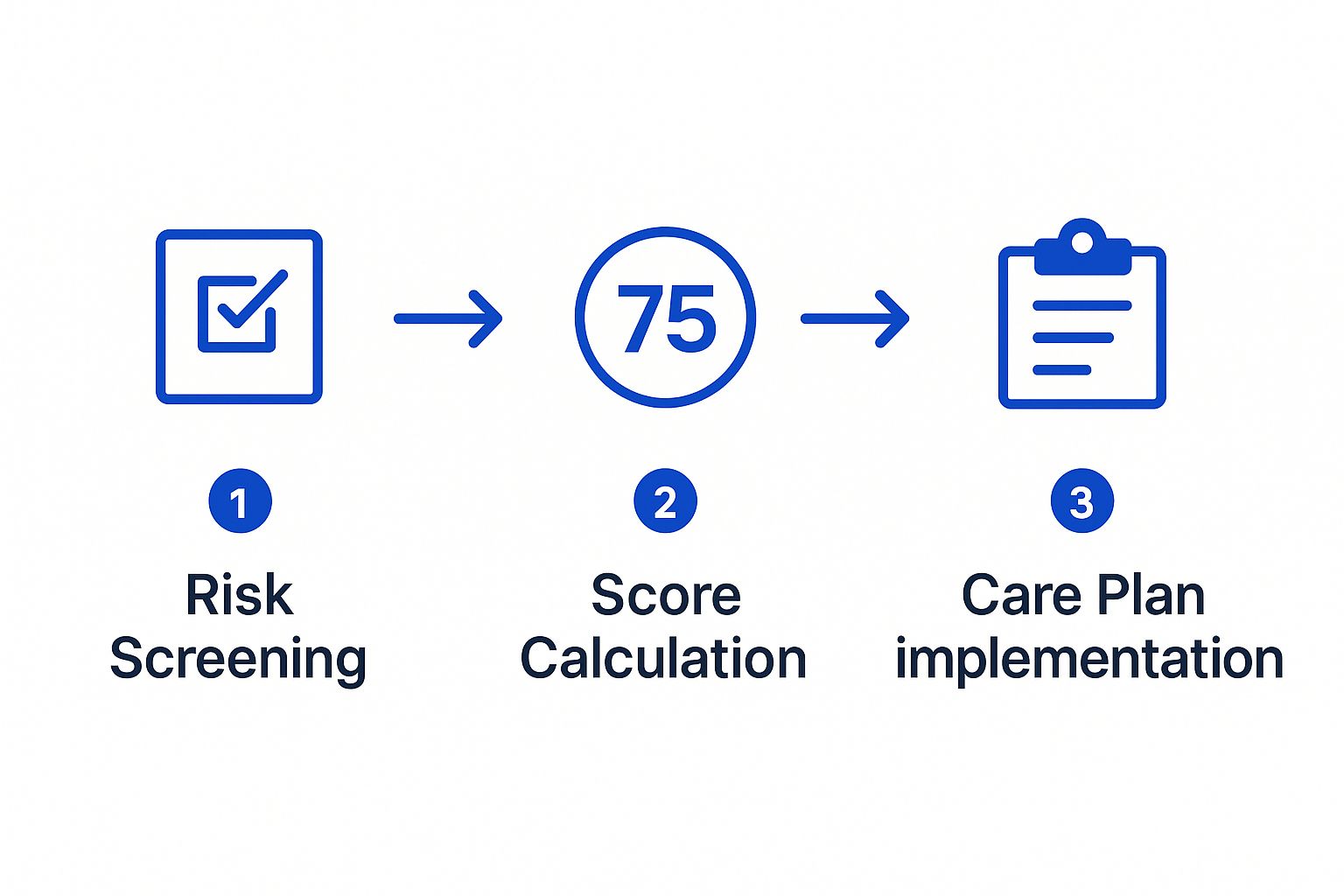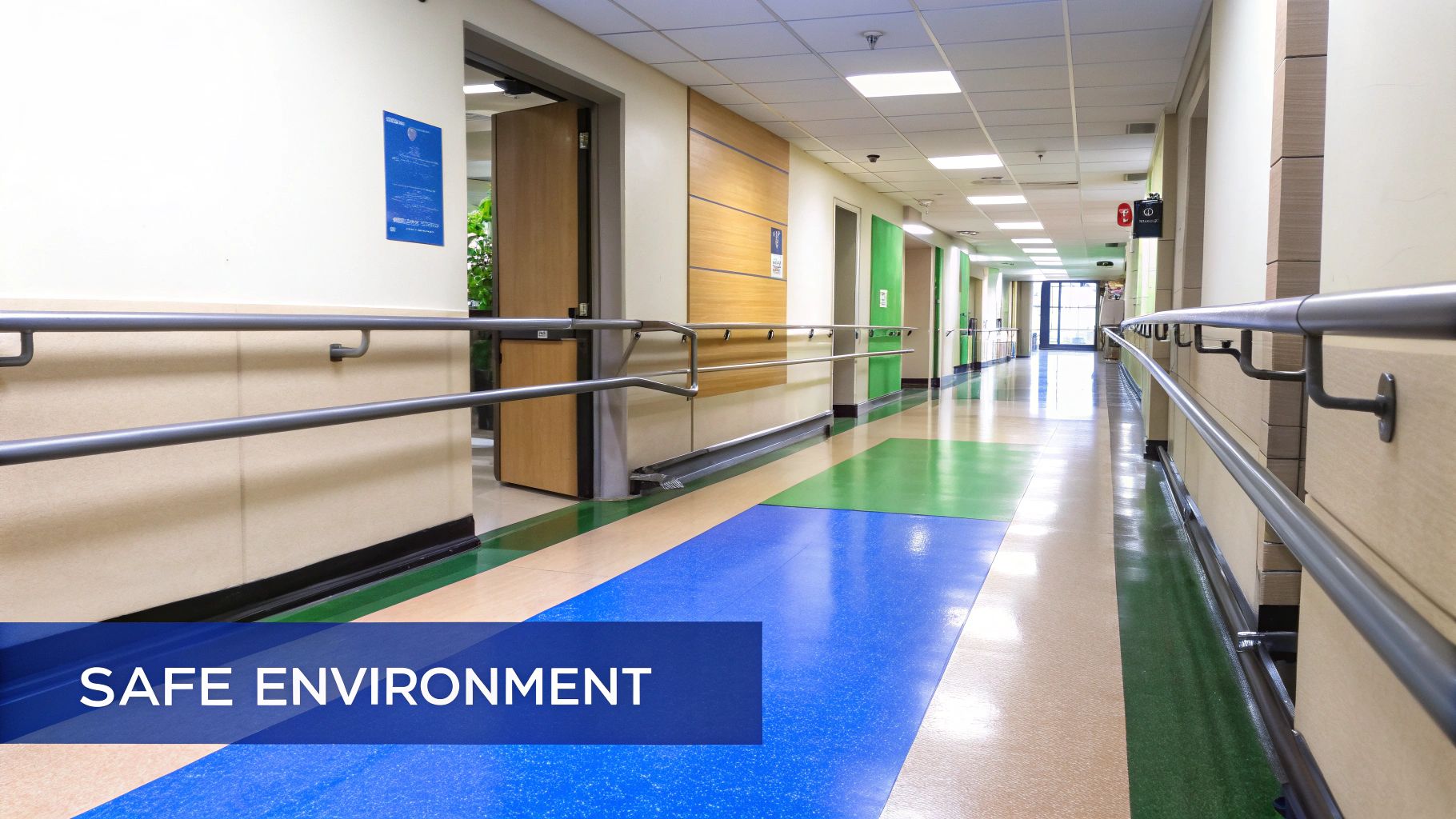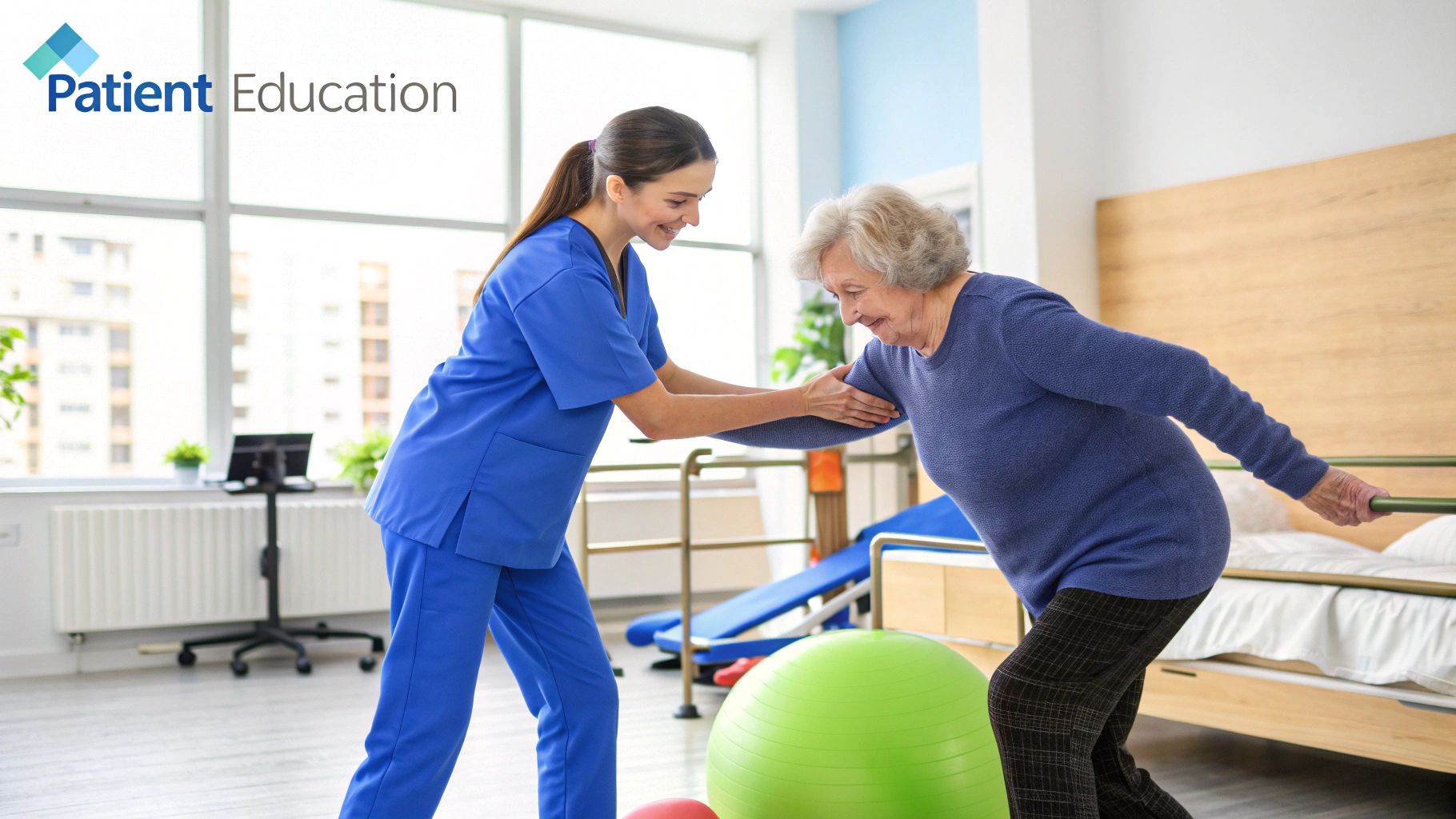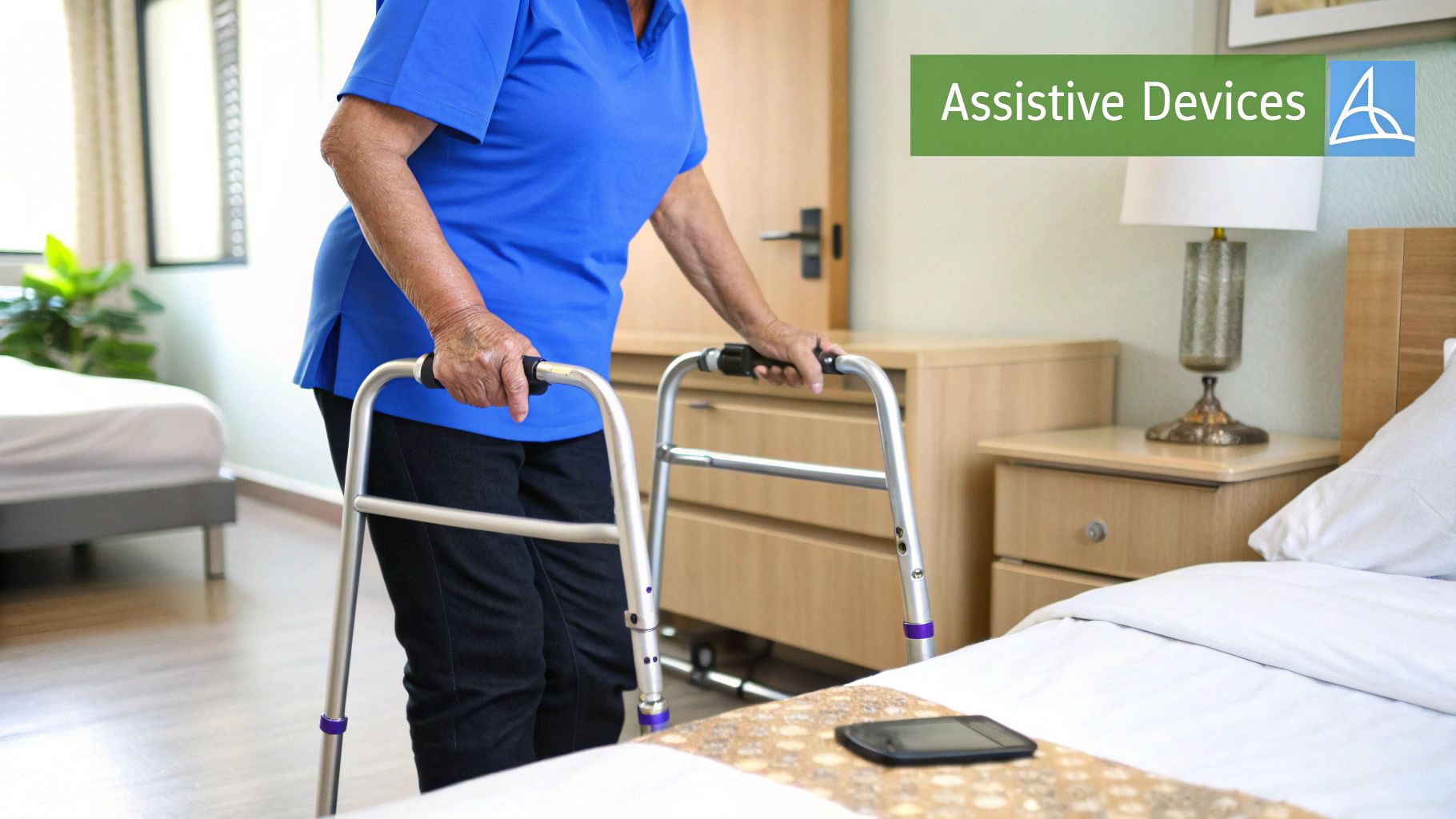When we talk about nursing interventions for falls, we're really talking about the proactive, evidence-based game plan a nurse puts into action to keep a patient safe. These aren't just reactions; they're smart, calculated moves.
These strategies can be anything from rearranging furniture in a room and double-checking medication side effects to teaching a patient how to move safely and providing mobility aids. The whole point is to spot someone who’s at risk before a fall ever happens and build a personalized safety net around them.
Why Fall Prevention Is a Core Nursing Responsibility
Patient falls are never just simple accidents. They're complex, often devastating events that can have life-altering consequences. For nurses on the front lines, preventing falls isn't just another item on a long to-do list—it's woven into the very fabric of providing safe, high-quality care. A patient's "falls risk" isn't a static label; think of it more as a dynamic, flashing warning light indicating their overall vulnerability.
The Nurse as a Safety Guardian
A great way to picture a nurse's role here is to think of an air traffic controller, but for patient safety. They are constantly scanning and processing multiple streams of information, all to guide the patient safely away from potential danger zones. This means catching the small, subtle shifts that could signal a spike in fall risk.
Some of these critical data points include:
- Medication Side Effects: Is that new blood pressure pill making them dizzy? Is a pain medication causing drowsiness?
- Cognitive Changes: Are they showing new signs of confusion or becoming disoriented more easily?
- Mobility Issues: Has their walk become more unsteady? Are they having trouble with their balance?
By piecing all this information together, a nurse can anticipate and head off hazards before they can cause any harm.
A nurse’s central role is not just reacting to falls, but proactively creating a culture of safety that preserves dignity, promotes healing, and protects patients from preventable harm.
A Global Health Imperative
The urgent need for this level of diligence is backed by some pretty staggering global statistics. Falls are a massive public health problem. The World Health Organization estimates that 684,000 fatal falls occur across the globe every single year.
This makes falls the second leading cause of unintentional injury deaths worldwide, with older adults being the most severely impacted. You can explore the full global impact of falls and learn more about this critical issue.
Ultimately, a nurse's dedication to fall prevention is a core part of being a patient advocate. It’s about making sure the very place a person comes to heal remains a safe space—free from preventable injuries that can derail recovery and chip away at their quality of life.
Mastering the Art of Fall Risk Assessment
Pinpointing a patient who is at risk for a fall is the single most important first step in preventing one. The best way to think about this process is like good old-fashioned detective work. A skilled nurse doesn’t just glance at a chart; they piece together a mosaic of clues to build a complete and accurate risk profile for every single person in their care. It’s a process that goes far deeper than a simple checklist.
This kind of comprehensive assessment is a true investigation, covering multiple angles. It involves a deep dive into the patient's medical history, a hands-on physical evaluation, and a careful cognitive screening. Every piece of information is a vital clue that helps reveal the full picture of their vulnerability.
Uncovering Clues in Patient History
The investigation always starts with the patient’s story, which you can find in their medical records and through direct conversations. A huge area of focus is polypharmacy—the clinical term for using multiple medications. Certain drugs, like sedatives, antihypertensives, or diuretics, can directly mess with balance and alertness, sending fall risk through the roof.
Chronic illnesses such as diabetes, arthritis, or heart disease also play a major role. These conditions can lead to weakness, nerve damage, or dizziness. By really understanding a patient’s full medical background, you can connect the dots and see which pre-existing conditions make them more likely to take a tumble. For a more detailed look at identifying hazards in a patient's environment, check out our guide on conducting a senior home safety assessment.
The Physical and Cognitive Evaluation
Next, it's time to shift from the records to the person. This is where the nurse gets to observe and assess the patient's physical capabilities firsthand.
- Gait and Balance: How steady are they when they walk? Do they sway, shuffle their feet, or need to hold onto something for support? Simple, observational tests can reveal subtle instabilities that aren't obvious at first glance.
- Muscle Strength: You have to assess the strength in their legs and core. Weakness in these key areas makes it incredibly difficult for a person to recover their balance if they start to stumble.
- Cognitive Status: Is the patient showing any signs of confusion, delirium, or dementia? An impaired ability to understand their own limitations or their surroundings is a massive risk factor.
This flow chart gives a great visual of how screening, scoring, and planning all fit together.

This kind of streamlined approach ensures every patient is evaluated systematically. It helps us quickly identify those at high risk so we can jump in with targeted care.
Using Standardized Assessment Tools
To bring some structure to this "detective work," nurses rely on standardized, evidence-based tools. Instruments like the Morse Fall Scale (MFS) or the Hendrich II Fall Risk Model provide a solid framework to guide our clinical judgment. They work by assigning numerical values to different risk factors, which helps quantify a patient’s overall risk level in a clear, consistent way.
These tools don’t replace a nurse’s clinical judgment—they sharpen it. They provide a consistent method for gathering data, ensuring no critical risk factor is overlooked.
For example, one quality improvement study perfectly highlighted the power of using the MFS. Researchers found that 56% of fallers had cognitive deficits and 36% showed confusion, which really underscores the need to assess these specific factors. Training the staff on a standardized tool was a cornerstone of their successful fall prevention strategy. Piecing all these findings together creates a clear, actionable picture of who is most vulnerable and lays the groundwork for precise and effective nursing interventions for falls risk.
Implementing Universal Fall Precautions for Every Patient

While targeted strategies for high-risk patients are critical, the real foundation of any solid fall prevention program is universal fall precautions. You can think of these as the ground rules for safety that apply to every single person you care for, no matter their fall risk score. This simple, consistent approach creates a much safer environment from the get-go, lowering the chance of a fall for everyone.
These precautions aren't complicated. They’re really just common-sense actions that, when you apply them faithfully, build a powerful safety net. It’s all about getting control of the environment to stamp out common hazards before they have a chance to cause a problem. This baseline of safety is so important because a patient's condition can shift in the blink of an eye—a low-risk person today could easily become high-risk tomorrow.
Creating a Safe Patient Space
Your first line of defense is the patient’s immediate surroundings. Let's be honest, a cluttered, dim room is just asking for a fall to happen. The mission is to create a space that’s predictable, clear, and easy to navigate.
Some key nursing interventions to manage the environment include:
- Decluttering Pathways: Make sure there's a wide, clear path from the bed to the bathroom and the door. That means moving any unnecessary furniture, personal belongings, or equipment out of the way.
- Ensuring Adequate Lighting: A bright room is a safe room, especially after dark. Use nightlights to light the way to the bathroom, and always keep light switches well within the patient's reach.
- Securing the Bed: The bed needs to be in its lowest possible position whenever the patient is in it. Just as important, the bed brakes must be always locked to keep it from shifting when they're getting in or out.
These small tweaks can make a huge difference in cutting down on environmental risks.
By establishing a baseline of safety for all, universal precautions ensure that even unassessed or sudden changes in a patient's condition are met with a safer environment.
Empowering the Patient with Essential Tools
Beyond just setting up the room, you have to empower the patient by making sure help and support are always within arm's reach. This means getting the right tools into their hands and confirming they know how to use them.
Simple tools can be incredibly powerful. For example, non-slip footwear is completely non-negotiable. Walking in regular socks or bare feet on a smooth floor is a recipe for disaster. Giving a patient well-fitting slippers or socks with rubber grips is an easy win.
The call light is just as crucial. It must always, always be easy for the patient to grab. Don't just place it nearby—have them show you they can reach it and use it. This little step confirms they understand what it’s for and can physically call for help if they need it. For more ideas, our guide to senior safety devices covers many other helpful tools. These small, consistent actions are what transform a standard room into a fortified zone of safety.
To make this easier to remember, here’s a quick checklist of the universal precautions we just covered.
Universal Fall Precautions Checklist
This table breaks down the standard safety measures that should be in place for every single patient to create a fundamentally safe environment.
| Precaution Category | Key Nursing Actions |
|---|---|
| Environmental Safety | Ensure clear pathways to the bathroom and door. Use nightlights and keep lighting controls within reach. Secure rugs and remove trip hazards. |
| Bed and Equipment | Keep the bed in the lowest position with brakes locked. Ensure wheelchairs and walkers are locked during transfers. |
| Patient Essentials | Place the call light, phone, water, and personal items within easy reach of the patient. Have the patient demonstrate they can use the call light. |
| Footwear and Clothing | Provide and encourage the use of non-slip socks or well-fitting shoes. Avoid long, trailing clothing that could be a trip hazard. |
| Patient Education | Orient the patient to their room and bathroom. Explain how to safely get up and move around, and instruct them to call for help before getting up. |
Implementing these universal actions consistently builds a culture of safety that protects everyone, reducing falls before they have a chance to happen.
Tailoring Interventions for High-Risk Patients

When an assessment flags a patient as high-risk, the standard, universal precautions just aren't going to cut it anymore. This is the point where a one-size-fits-all approach gets tossed out the window in favor of a highly customized care plan.
Think of it as moving from general safety guidelines to a precise, tactical strategy. We’re designing a plan for one specific person and their unique set of vulnerabilities.
This personalized care plan isn't a solo mission. It’s a collaborative effort bringing together the nurse, the patient, their family, and other healthcare pros like physical therapists and pharmacists. Each person brings a critical piece of the puzzle, helping to build a multi-layered defense against falls.
Interventions for Mobility and Weakness
For patients whose biggest risks are poor mobility, an unstable gait, or muscle weakness, our interventions have to tackle those physical challenges head-on. Simply telling them to "be careful" is a waste of breath. The focus has to shift to providing structured support and actively building strength.
A consultation with a physical therapist is often the most critical first step. They can design specific routines to improve balance and leg strength, which are game-changers for stability. For a practical starting point, you can explore targeted fall prevention exercises for seniors that can be adapted for different ability levels: https://njcaregiving.com/fall-prevention-exercises-for-seniors/
Other key nursing actions include:
- Scheduled Toileting: Getting the patient to the bathroom on a regular, predictable schedule can prevent those rushed, unassisted trips that so often lead to falls.
- Mobility Assistance: We have to ensure the patient uses their walker or cane correctly every single time they move. This might mean providing hands-on assistance during transfers from a bed to a chair.
- Medication Review: Working with a pharmacist to review medications is crucial. Some drugs can cause dizziness or weakness, directly impacting a person's ability to stay on their feet.
This proactive support system helps make up for physical deficits while the patient works on getting stronger.
Rather than focusing solely on the patient’s fall risk score, a personalized care plan collaborates with the patient and their family to address each specific risk factor. This creates a more effective and dignified approach to safety.
Addressing Cognitive and Sensory Deficits
When a patient's risk comes from confusion, dementia, or sensory impairments, our interventions have to create a safer, more predictable environment. These patients may not recognize their own limitations, which makes external safeguards absolutely essential.
For instance, a patient with dementia might forget they need help getting out of bed. In this case, technology can provide an extra layer of security. Bed or chair alarms can alert staff the moment the patient tries to stand up on their own, allowing for a quick response before a fall happens.
Additional strategies include:
- Enhanced Supervision: This could be as simple as moving the patient closer to the nursing station or using a virtual sitter for continuous observation.
- Visual Cues: You'd be surprised how effective simple cues can be. A brightly colored sign on the wall reminding them to use the call light can make all the difference for someone with mild confusion.
- Clear Communication: Always use simple, direct language. Break down instructions into small, easy-to-follow steps to avoid overwhelming them.
By tailoring these specific nursing interventions for falls risk, you move way beyond a generic checklist. You create a dynamic, responsive safety net that adapts to the individual, providing protection exactly where it’s needed most.
Navigating High-Risk Healthcare Environments

Hospitals and nursing homes are designed for healing, but they can be tricky places. For an older adult, the unfamiliar layout, constant activity, and medical equipment can be disorienting and actually increase their risk of falling.
This is where a broader, facility-wide approach to safety makes all the difference. Instead of just reacting to incidents, the best strategies create a culture of safety that proactively protects everyone. It's about building a system that anticipates needs and prevents falls before they happen.
Proactive Strategies for System-Wide Safety
One of the most powerful nursing interventions for falls risk is something called intentional rounding. This isn't just popping in to say hello; it's a scheduled, structured check-in where nurses address common needs before they become a problem. Many facilities use the simple but effective "4 Ps" framework:
- Pain: Is the patient comfortable and free of pain?
- Potty: Do they need help getting to the restroom?
- Positioning: Is the patient comfortable, or do they need to be repositioned?
- Proximity: Are important items like the call light, phone, and water within easy reach?
By routinely checking on these four things, nurses can often prevent a patient from trying to get up on their own to solve a problem—a very common reason for falls.
Learning from Every Incident
Of course, even with the best plans, falls can still happen. What you do next is critical. A post-fall huddle is an immediate, on-the-spot meeting with the whole care team—nurses, aides, therapists, everyone involved. The goal is never to place blame, but to figure out exactly what happened.
This quick, collaborative debrief turns every fall into a powerful learning opportunity. The team can pinpoint the root cause—was it a new medication, a slippery spot on the floor, or poor lighting?—and adjust the patient's care plan right away to prevent it from happening again.
This simple practice builds a culture of continuous improvement, where everyone shares the responsibility for keeping patients safe. It ensures that valuable insights aren't lost and that the entire system gets stronger and safer over time.
The hard truth is that falls are a massive issue, especially in long-term care. In nursing homes, the rate can be higher than 2.5 falls per person each year. When you see numbers that high, it often signals a bigger problem, like staffing shortages or environmental hazards. You can read more about fall rates in nursing facilities to get a better sense of the challenge. By putting strong, system-level strategies in place, facilities can build a much more effective defense against preventable falls.
Closing the Loop with Continuous Evaluation
A good fall prevention plan isn't something you create once and file away. It's a living, breathing strategy that has to adapt. The final, and maybe most important, piece of the puzzle is continuous evaluation. This is where you close the loop, making sure the plan is actually working and tweaking it as your client’s needs change.
Think of it like being a pilot. You wouldn't just set the autopilot and take a nap; you'd constantly check your instruments and adjust for turbulence. A care plan that was perfect on Monday might be totally off by Wednesday. This constant monitoring is one of the most essential nursing interventions for falls risk because it keeps your plan relevant.
It’s this ongoing cycle that ensures your strategies are truly protecting your client, day in and day out.
The Critical Post-Fall Assessment
Even with the best plan in place, a fall can still happen. What you do in the moments after is crucial, both for the person’s immediate safety and for preventing the next incident. Your first priority is always to assess for injury before even thinking about moving them.
Once you know they're safe, the real detective work begins. A post-fall assessment, sometimes called a huddle, needs to happen right away to figure out exactly what went wrong.
- Gather the Facts: What was the person doing right before they fell? Where did it happen? Have they started any new medications recently?
- Find the Cause: Dig deep to find the root cause. Was it something in the environment, a change in their health, or a medication side effect?
- Refine the Plan: Use this fresh information to update the care plan immediately. The new interventions need to be more specific and targeted.
A fall is never just a random event; it's a critical piece of data. It gives you an invaluable look into a client's changing condition and shines a spotlight on gaps in the safety plan that you need to fix.
This immediate analysis turns a negative event into a powerful learning opportunity.
Tracking and Adapting for Long-Term Success
Beyond looking at single incidents, you also need to step back and see the bigger picture. Are you tracking things like how often falls are happening or how severe the injuries are? This kind of data helps you measure if your overall approach is working.
By looking at trends over time, you can make smarter, system-wide improvements. A culture of safety isn't about being perfect; it's about constantly learning, adapting, and getting better at meeting new challenges head-on.
Common Questions About Fall Prevention
When you're working to keep seniors safe at home, a lot of practical questions come up. Let's tackle some of the most common ones that nurses face when setting up nursing interventions for falls risk.
Which Fall Risk Assessment Tool Is Best?
This is a question I hear a lot, and the honest answer is: there isn't one single "best" tool for every person in every situation. The right one really depends on the clinical setting and the specific needs of the senior you're caring for.
For instance, the Morse Fall Scale (MFS) is a go-to in many acute care hospitals. But for a home setting, something like the Hendrich II Fall Risk Model might be more useful because it really zeroes in on factors like confusion or the side effects of certain medications.
What truly matters is that an organization picks one standardized tool and sticks with it. Everyone on the team needs to be trained on how to use it correctly and apply it the same way, every time. Think of these tools as a guide to sharpen your clinical judgment, not replace it.
How Can I Get the Family Involved?
Bringing the family into the fold is a huge advantage in preventing falls. A great first step is simply sitting down with them and explaining their loved one's specific risks and walking them through the safety plan you've put in place.
Here are a few easy, practical ways they can make a real difference:
- Bring in the Right Footwear: Ask them to provide well-fitting shoes or slippers with non-slip soles. This is such a simple fix that often gets overlooked.
- Be an Extra Set of Eyes: Encourage them to let you know if they notice any new confusion, dizziness, or unsteadiness. They often spot subtle changes first.
- Keep the Space Clear: When they visit, they can help make sure the area around the bed or favorite chair is free of clutter and tripping hazards.
When you work together like this, you build a much stronger and more consistent safety net for the person you're caring for.
The absolute first priority after a fall is ensuring the person is safe. You must assess for any injury—especially to the head, neck, and spine—before you even think about moving them.
Once you've confirmed they're safe to move, help them back to a bed or a chair. After that, run through a full set of vitals and a neurological check, get the physician and family on the phone, and fill out an incident report to figure out exactly what happened.
At NJ Caregiving, we know just how critical it is to create a safe and secure home environment. Our team of skilled nurses and caregivers are experts in identifying risks and implementing personalized fall prevention plans. To learn more about how our in-home care services can bring peace of mind to you and your family, please visit us online.


